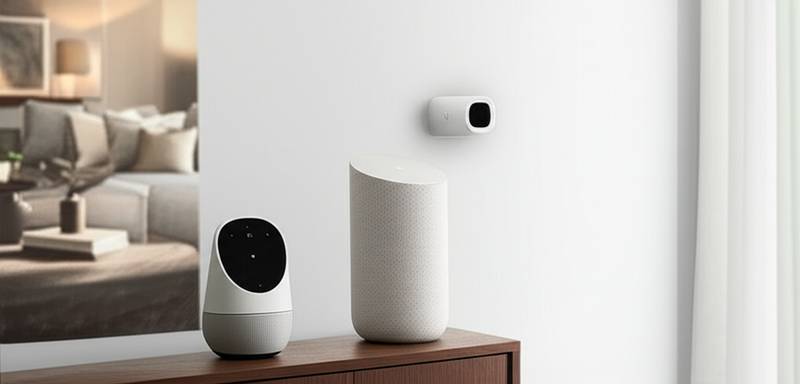Voice Control: Enhancing Smart Home Security
Consider entering your home carrying groceries and stating, "Lock the door behind me." The door secures, the alarm activates, and lights adjust to an unoccupied setting. Voice-controlled smart home security realizes this scenario by designating your voice as the primary access method.
Challenges in Contemporary Home Security
Individuals often invest in smart cameras or electronic locks, yet coordination remains cumbersome. Disarming an alarm requires retrieving a phone, or locking a door slips the mind before retiring for the night. Automation helps, but fragmentation persists when devices operate via separate applications. Voice integration offers a unified, intuitive interface to resolve these issues.
Streamlining Security Through Voice Commands
Voice control converts intricate setups into straightforward directives. Platforms such as Alexa, Google Assistant, or Siri enable immediate home status checks, lock operations, or camera activations. This extends beyond mere ease; it promotes proactive measures and broad household accessibility.
Appropriate configurations allow voice commands to manage specific functions:
- Securing doors or engaging alarms without screen interaction.
- Displaying live camera footage on compatible screens.
- Delivering audible notifications from motion or door sensors.
- Establishing routines that synchronize lighting, locking, and monitoring in a single utterance.
Constructing a Voice-Enabled Security Network
Establish a dependable framework by selecting a voice assistant aligned with daily habits. Various ecosystems provide distinct advantages across compatible hardware.
Select an Appropriate Central Device
- Affordable Selection: Amazon Echo Dot (5th Generation), priced at approximately $50. This compact unit connects seamlessly with Ring products and numerous smart locks.
- Intermediate Option: Google Nest Hub (2nd Generation), priced at about $100. It includes a display for visual feeds and excels in Google Home automation sequences.
- High-End Recommendation: Apple HomePod Mini combined with HomeKit devices, each at around $100. These emphasize robust privacy features and on-device processing.
The chosen device influences compatible brands. Alexa accommodates the broadest array of external products, whereas Apple focuses on encrypted, privacy-centric operations.
Integrate Intelligent Locks and Alarm Systems
Contemporary locks including the Wyze Lock Bolt ($80), August Wi-Fi Smart Lock ($200), or Yale Assure Lock 2 ($260) support voice directives for verification or remote engagement. Combine these with comprehensive solutions like Ring Alarm Pro or SimpliSafe to achieve property-wide safeguards responsive to verbal input.
Incorporate Cameras and Detection Sensors
Devices from Arlo, Eufy, or Blink now activate via voice for real-time viewing. Utter "Display the backyard view," and the screen presents the stream promptly. Pair these with sensors that initiate illumination and spoken warnings, forming an adaptive boundary defense.
Essential Advice: Implement Voice Authentication Codes
Experienced users enhance protection by configuring voice PINs for high-risk actions such as door unlocking or alarm deactivation. Overlooking this exposes systems to external manipulation, like commands issued from outside. Within Alexa configurations, define distinct codes for vital operations. This minor adjustment significantly bolsters overall security.
Addressing Privacy and Operational Safety
Constantly active listening devices prompt valid privacy concerns. Integrate assistants into the security framework rather than isolating them. Deactivate microphones in vulnerable locations, examine interaction histories regularly, and opt for on-site data storage where possible.
For monitored services, ensure platforms employ secure transmission and multi-step verification. When linking locks or alarms to voice sequences, confirm applications provide detailed usage records to monitor command origins and timings.
Budget, Setup, and Future-Proofing
A voice-enhanced system for a standard three-bedroom residence typically costs $400 to $1,200, varying by component standards and extent. Many begin with a single lock and central unit, gradually incorporating cameras and detectors as familiarity increases.
Self-installation suits most elements, although wiring for entry cameras or exterior lights may require professional input. Disconnect power sources prior to any electrical work, and consult a certified electrician if uncertain.
Wi-Fi updates maintain system relevance without physical modifications. Initial expenditures thus evolve, delivering sustained enhancements.
Benefits of Effortless Voice Management
Voice-directed security captivates through its intuitive integration into routines. A phrase like "Prepare for night" can secure entrances, dim interior lights, and enable alarms in sequence. This eliminates daily hurdles while fostering tranquility.
In families with young children or seniors, voice access eases safety protocols. Members summon assistance or initiate emergency protocols without device handling. Such functionality transcends convenience, advancing inclusive protection.
Steps to Implementation
Evaluate aspects of current security that demand improvement, such as nighttime verifications or app navigation. Acquire a compatible central device and initial accessory to test integration. The simplicity of verbal control encourages further development.
As expansion occurs, develop personalized sequences. A "Departing" directive might secure all entries, deactivate indoor illumination, and engage perimeter cameras. A "Returning" command could neutralize alarms and light pathways. These automations gradually position voice as a dependable guardian.
Voice-enabled home security transitions from innovative option to essential tool. It delivers intuitive oversight, surpassing the inconsistencies of manual or app-based methods. From comprehensive setups to basic enhancements, this technology adapts to individual needs, enabling secure living through spoken intent.
Frequently Asked Questions
Can voice assistants operate all types of smart locks for locking and unlocking?
Compatibility depends on the lock's support for the selected platform. Verify integration capabilities prior to acquisition.
What measures ensure voice commands remain private?
Enable encryption, review activity logs, and use local processing to minimize data exposure.
How do voice routines enhance daily security?
Routines combine multiple actions into one command, reducing errors and improving response times.
